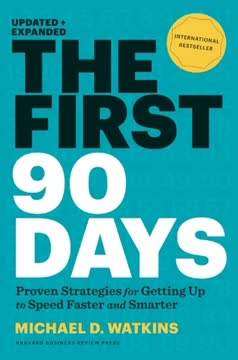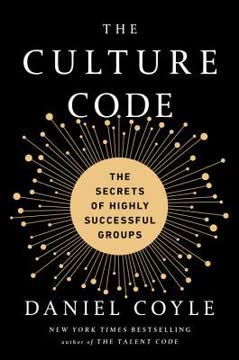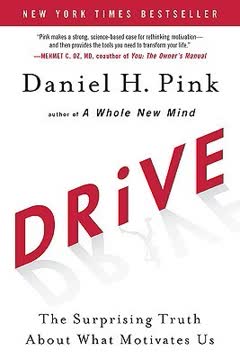가지 주요 요점
1. 강력한 질문을 통해 더 효과적인 리더가 되기
첫 번째 문제를 해결하려는 유혹을 관리할 방법이 필요합니다.
코칭 습관. 이 책은 즉각적인 해결책을 제공하는 대신 강력한 질문을 던지는 새로운 리더십 접근 방식을 소개합니다. 조언을 주는 것에서 호기심을 기반으로 한 질문으로 전환함으로써, 리더는 팀의 잠재력을 발휘하고 더 큰 자율성과 성장을 촉진할 수 있습니다.
일곱 가지 필수 질문. 이 접근 방식의 핵심은 다음과 같은 일곱 가지 신중하게 구성된 질문입니다:
- 당신의 마음속에 무엇이 있습니까? (시작 질문)
- 그리고 또 무엇이 있습니까? (AWE 질문)
- 여기서 당신에게 진짜 도전 과제는 무엇입니까? (집중 질문)
- 당신은 무엇을 원합니까? (기초 질문)
- 제가 어떻게 도와드릴까요? (게으른 질문)
- 이것에 예스라고 한다면, 무엇에 노라고 하는 것입니까? (전략적 질문)
- 무엇이 가장 유용했습니까? (학습 질문)
이 질문들을 숙달함으로써, 리더는 더 의미 있는 대화를 만들고, 팀원들이 스스로 해결책을 찾도록 도우며, 궁극적으로 더 효과적인 역할을 수행할 수 있습니다.
2. "시작 질문"을 사용하여 의미 있는 대화를 시작하기
"당신의 마음속에 무엇이 있습니까?"는 가장 중요한 것에 대해 이야기하자는 질문입니다.
개방적이면서도 집중된 질문. "당신의 마음속에 무엇이 있습니까?"라는 시작 질문은 강력한 대화 시작 도구입니다. 이 질문은 상대방이 가장 중요한 것을 꺼내도록 하면서도, 무의미한 잡담을 피할 수 있게 합니다.
3P 모델. 대화를 더 집중시키기 위해 3P 모델을 사용하세요:
- 프로젝트: 상황의 내용
- 사람들: 관계와 상호작용
- 패턴: 행동과 작업 방식
이 질문과 모델을 사용함으로써, 리더는 빠르게 의미 있는 논의를 시작하고 팀원들이 직면한 가장 시급한 문제를 다룰 수 있습니다.
3. "AWE 질문"을 사용하여 더 많은 옵션과 통찰을 생성하기
"그리고 또 무엇이 있습니까?"—AWE 질문—은 마법 같은 속성을 가지고 있습니다.
잠재력 발휘. "그리고 또 무엇이 있습니까?"라는 AWE 질문은 간단하지만 강력한 도구로, 더 많은 아이디어와 통찰을 생성할 수 있습니다. 이 질문을 여러 번 물어봄으로써, 리더는 팀원들이 처음에는 고려하지 않았던 옵션을 발견하도록 도울 수 있습니다.
AWE 질문의 이점:
- 더 많은 옵션을 생성하여 더 나은 결정을 내릴 수 있음
- 리더의 "조언 몬스터"를 억제하고 호기심을 장려함
- 리더가 정보를 처리할 시간을 벌어줌
- 더 깊은 사고와 성찰의 공간을 만듦
대화 중 이 질문을 최소 세 번 물어보아 주제를 충분히 탐구하세요.
4. "집중 질문"으로 진짜 도전에 집중하기
진짜 문제에 집중하세요, 첫 번째 문제에 집중하지 마세요.
더 깊이 파고들기. "여기서 당신에게 진짜 도전 과제는 무엇입니까?"라는 집중 질문은 리더와 팀원들이 핵심 문제를 식별하도록 돕습니다. 종종 처음 제시된 문제는 실제로 해결해야 할 진짜 도전 과제가 아닙니다.
일반적인 함정 다루기:
- 문제의 확산: 한 번에 너무 많은 문제 제시
- 유령 코칭: 실제 문제 대신 제3자에 대해 논의
- 추상화 및 일반화: 모호하고 고차원적인 논의
집중 질문을 사용함으로써, 리더는 이러한 모호한 상황을 뚫고 진짜 도전에 집중하여 더 효과적인 문제 해결과 의사 결정을 할 수 있습니다.
5. "기초 질문"으로 진정한 욕구 발견하기
자신의 자유에 대한 책임을 지는 것은 notoriously 어렵습니다.
성인 대 성인 대화. "당신은 무엇을 원합니까?"라는 기초 질문은 직장에서 성숙하고 생산적인 관계의 핵심입니다. 이 질문은 사람들이 자신의 필요와 욕구에 대한 책임을 지도록 장려합니다.
답변의 어려움:
- 사람들은 종종 자신이 무엇을 원하는지 모름
- 원하는 것을 요청하는 것이 어려울 수 있음
- 욕구를 명확하게 전달하는 것이 어려울 수 있음
- "노"라는 답변을 듣는 것이 불편할 수 있음
이 질문을 정기적으로 물어봄으로써, 리더는 명확성, 직설성, 상호 존중의 문화를 조성하여 더 효과적인 협업과 문제 해결을 이끌어낼 수 있습니다.
6. "게으른 질문"으로 과도한 약속 피하기
제가 어떻게 도와드릴까요?
요청 명확화. "제가 어떻게 도와드릴까요?"라는 게으른 질문은 두 가지 중요한 목적을 수행합니다. 첫째, 상대방이 명확하고 구체적인 요청을 하도록 강요합니다. 둘째, 리더가 상황을 완전히 이해하지 못한 채 행동에 뛰어들지 않도록 방지합니다.
"게으른" 접근의 이점:
- 명확한 의사소통을 장려함
- 불필요한 작업이나 잘못된 도움을 방지함
- 리더가 요청을 이행할 수 있는지 또는 이행해야 하는지 평가할 수 있게 함
- 팀원들이 자신의 필요를 스스로 생각하도록 권장함
이 "게으른" 접근을 수용함으로써, 리더는 과도한 약속을 피하고 자신의 노력이 팀의 필요와 진정으로 일치하도록 할 수 있습니다.
7. "전략적 질문"을 사용하여 전략적 결정 내리기
예스는 그것에 경계를 주는 노 없이는 아무것도 아닙니다.
신중한 약속. "이것에 예스라고 한다면, 무엇에 노라고 하는 것입니까?"라는 전략적 질문은 리더와 팀원들이 더 의도적인 결정을 내리도록 돕습니다. 이 질문은 어떤 약속에 수반되는 트레이드오프를 고려하도록 장려합니다.
고려해야 할 "노"의 유형:
- 생략의 노: 예스를 함으로써 자동으로 제거되는 옵션은 무엇인가?
- 실행의 노: 예스를 가능하게 하기 위해 중단하거나 변경해야 할 것은 무엇인가?
이 질문을 정기적으로 물어봄으로써, 리더는 팀이 효과적으로 우선순위를 정하고 과도한 약속을 피하며, 그들의 노력이 전략적 목표와 일치하도록 도울 수 있습니다.
8. "학습 질문"을 통해 학습 내재화하기
잊어버리는 과정을 방해하는 것이 중요합니다.
이중 고리 학습. "무엇이 가장 유용했습니까?"라는 학습 질문은 대화나 회의가 끝날 때 성찰과 통찰의 순간을 만듭니다. 이 질문은 즉각적인 문제를 해결하는 것뿐만 아니라, 과정 자체에 대한 학습 순간을 만드는 "이중 고리 학습"을 장려합니다.
학습 질문의 이점:
- 대화가 유용했다고 가정하여 긍정적으로 프레임함
- 주요 시사점을 식별하도록 장려함
- 학습을 개인적이고 주관적으로 만듦
- 리더에게 피드백을 제공함
- 상호작용의 가치를 강화함
이 질문을 일관되게 사용함으로써, 리더는 팀원들이 모든 상호작용에서 최대한의 가치를 추출하고 지속적으로 기술과 지식을 향상시킬 수 있도록 도울 수 있습니다.
9. 새로운 습관을 형성하여 리더십 접근 방식 변혁하기
새로운 습관을 추상적이고 약간 모호하게 정의하면, 추진력을 얻지 못할 것입니다.
새로운 습관 공식. 행동을 효과적으로 변화시키고 코칭 습관을 구현하기 위해, 리더는 다음 공식을 사용해야 합니다:
- 트리거 식별: 이것이 발생할 때...
- 오래된 습관 식별: 대신에...
- 새로운 행동 정의: 나는...
성공적인 습관 형성의 열쇠:
- 트리거와 새로운 행동에 대해 구체적으로 정의하기
- 새로운 습관을 짧게 유지하기 (60초 미만)
- 반복과 마음챙김을 통해 깊이 연습하기
- 좌절에 대비하고 다시 궤도에 오르는 방법 계획하기
이 강력한 질문들을 중심으로 새로운 습관을 의식적으로 형성함으로써, 리더는 관리와 코칭 접근 방식을 변혁할 수 있습니다.
10. 참여의 신경과학을 수용하여 더 나은 관계 형성하기
무의식적으로, 당신의 뇌는 주변 환경을 초당 다섯 번 스캔하며 스스로에게 묻습니다: 여기가 안전한가? 아니면 위험한가?
TERA 모델. 참여의 신경과학을 이해함으로써, 리더는 더 나은 관계와 생산성을 촉진하는 환경을 만들 수 있습니다. TERA 모델은 참여의 네 가지 주요 동인을 설명합니다:
- 부족: 당신은 나와 함께 있습니까 아니면 반대입니까?
- 기대: 무슨 일이 일어날지 알고 있습니까?
- 순위: 나의 상대적 중요성은 무엇입니까?
- 자율성: 선택할 수 있습니까?
리더십에서 TERA 적용하기:
- 부족과 자율성의 감각을 높이기 위해 질문하기
- 가능한 한 명확한 기대 제공하기
- 적극적인 경청을 통해 다른 사람의 지위를 존중하고 높이기
- 선택을 제공하고 독립적인 문제 해결을 장려하기
이 신경학적 동인들을 상호작용에 고려함으로써, 리더는 팀을 위한 더 참여적이고 생산적이며 긍정적인 작업 환경을 만들 수 있습니다.
마지막 업데이트 날짜:
FAQ
What's "The Coaching Habit" about?
- Purpose of the Book: "The Coaching Habit" by Michael Bungay Stanier is about transforming managers and leaders into more coach-like figures by encouraging them to stay curious longer and rush to action and advice-giving more slowly.
- Core Concept: The book introduces a simple yet challenging habit: asking more questions and giving less advice to foster better leadership and management.
- Practical Approach: It provides a fast and practical read, offering seven essential questions that can be used to improve coaching skills in everyday interactions.
- Not Just for Coaches: The book is designed for anyone in a leadership role, not just professional coaches, aiming to enhance their ability to support and develop their teams effectively.
Why should I read "The Coaching Habit"?
- Improve Leadership Skills: The book offers practical tools to become a more effective leader by adopting a coaching mindset.
- Enhance Team Performance: By using the seven questions, leaders can help their teams become more self-sufficient and focused on meaningful work.
- Reduce Overwhelm: It provides strategies to manage workload better and avoid becoming a bottleneck in the organization.
- Build Better Relationships: The book emphasizes the importance of adult-to-adult conversations, helping leaders build more authentic and productive relationships with their teams.
What are the key takeaways of "The Coaching Habit"?
- Seven Essential Questions: The book revolves around seven questions that help leaders coach more effectively by focusing on what truly matters.
- Habit Building: It emphasizes the importance of building a coaching habit through understanding triggers, practicing deeply, and planning for setbacks.
- Focus on Development: The book distinguishes between coaching for performance and coaching for development, encouraging leaders to focus on the latter for long-term growth.
- Engagement and Impact: By asking the right questions, leaders can increase engagement, reduce dependency, and have a greater impact on their teams.
What are the seven essential questions in "The Coaching Habit"?
- The Kickstart Question: "What's on your mind?" to open up meaningful conversations.
- The AWE Question: "And what else?" to explore more options and insights.
- The Focus Question: "What's the real challenge here for you?" to identify the core issue.
- The Foundation Question: "What do you want?" to clarify needs and desires.
- The Lazy Question: "How can I help?" to offer support without taking over.
- The Strategic Question: "If you're saying Yes to this, what are you saying No to?" to prioritize effectively.
- The Learning Question: "What was most useful for you?" to reinforce learning and reflection.
How does "The Coaching Habit" suggest building a coaching habit?
- Identify Triggers: Recognize the moments that prompt old habits and use them to initiate new behaviors.
- Practice Deeply: Focus on small, specific actions that can be repeated and refined over time.
- Plan for Setbacks: Accept that mistakes will happen and have a plan to get back on track.
- Use the New Habit Formula: Combine triggers, old habits, and new behaviors to create lasting change.
What is the difference between coaching for performance and coaching for development in "The Coaching Habit"?
- Coaching for Performance: Focuses on addressing and fixing specific problems or challenges, often short-term and task-oriented.
- Coaching for Development: Shifts the focus to the person dealing with the issue, aiming for long-term growth and learning.
- More Powerful Conversations: Development coaching is more impactful as it encourages self-awareness and personal growth.
- Application of the 3P Model: Helps identify whether the focus should be on projects, people, or patterns to facilitate development.
How does "The Coaching Habit" address the issue of overdependence in teams?
- Encourages Self-Sufficiency: By asking questions instead of giving answers, leaders help team members find their own solutions.
- Reduces Bottlenecks: Leaders avoid becoming the sole problem-solvers, allowing the team to function more independently.
- Increases Autonomy: Team members gain a sense of mastery and control over their work, leading to higher motivation.
- Breaks Vicious Circles: The book identifies and provides strategies to break cycles of overdependence, overwhelm, and disconnection.
What role does neuroscience play in "The Coaching Habit"?
- Risk and Reward Response: The book explains how the brain constantly assesses situations as safe or dangerous, influencing engagement.
- TERA Quotient: Focuses on increasing Tribe, Expectation, Rank, and Autonomy to create a rewarding environment.
- Impact on Engagement: By asking questions, leaders can create a sense of safety and engagement, enhancing team performance.
- Learning and Memory: The book uses neuroscience to explain how asking questions can improve memory retention and learning.
What are some of the best quotes from "The Coaching Habit" and what do they mean?
- "Tell less and ask more." This quote encapsulates the book's core message of shifting from giving advice to asking questions to empower others.
- "We live in the world our questions create." It highlights the transformative power of questions in shaping our understanding and interactions.
- "What people think of as the moment of discovery is really the discovery of the question." This emphasizes the importance of asking the right questions to unlock insights and solutions.
- "Nothing is stronger than habit." It underscores the book's focus on building new habits to create lasting change in leadership behavior.
How does "The Coaching Habit" suggest handling the Advice Monster?
- Recognize the Urge: Be aware of the tendency to jump in with advice and solutions, often prematurely.
- Use the AWE Question: "And what else?" helps manage the impulse to give advice by encouraging further exploration.
- Stay Curious: Focus on asking questions and listening to the answers to keep the conversation open and productive.
- Practice Restraint: Develop the habit of holding back advice until it's truly needed, allowing others to find their own solutions.
How can "The Coaching Habit" help with strategic decision-making?
- The Strategic Question: "If you're saying Yes to this, what are you saying No to?" helps prioritize and focus on what truly matters.
- Clarifies Commitments: Encourages clear and committed Yes decisions, supported by necessary No actions.
- Avoids Overwhelm: Helps leaders and teams manage workload by making conscious choices about priorities.
- Aligns with Goals: Ensures that decisions are aligned with strategic objectives and long-term goals.
What additional resources does "The Coaching Habit" offer for further learning?
- My One Best Question Series: Features videos from business leaders and thought leaders sharing their best questions.
- Top-Shelf Management Books: A curated list of recommended books for further reading on self-management, organizational change, and strategy.
- Box of Crayons Lab: Offers insights and research sources for deeper understanding of the book's concepts.
- Online Tools and Videos: Provides access to videos and tools to help embed the learning and apply the book's principles in real life.
리뷰
코칭 습관은 다양한 평가를 받고 있으며, 많은 사람들이 일곱 가지 핵심 질문을 통해 코칭에 접근하는 실용적인 방법을 칭찬하고 있다. 독자들은 이 책의 간결한 형식과 실행 가능한 조언을 높이 평가하며, 리더십과 의사소통 기술을 향상시키는 데 유용하다고 생각한다. 일부는 책이 반복적이거나 깊이가 부족하다고 비판하기도 한다. 많은 독자들은 조언을 주기보다는 질문을 하는 것에 중점을 둔 점을 가치 있게 여긴다. 책의 동반 비디오와 다른 작품에 대한 언급도 대체로 호평을 받고 있다. 전반적으로, 코칭 마인드를 개발하려는 사람들에게 유용한 자원으로 간주된다.
Similar Books


















